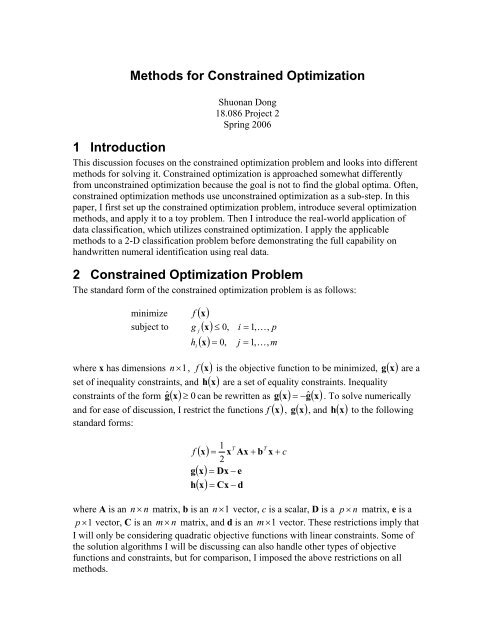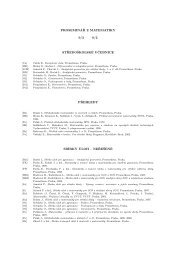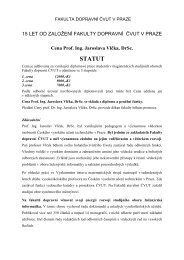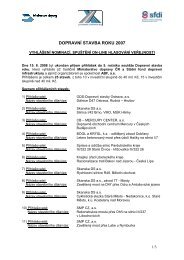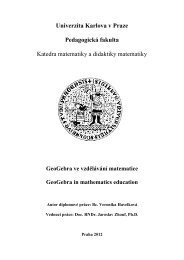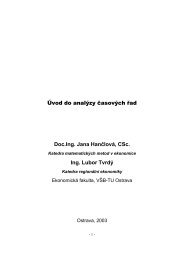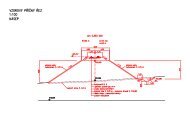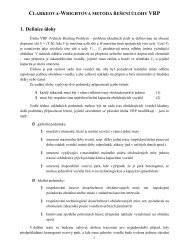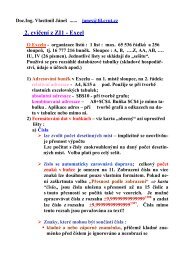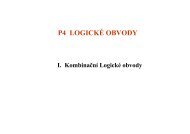Methods for Constrained Optimization - MIT Certificate Error
Methods for Constrained Optimization - MIT Certificate Error
Methods for Constrained Optimization - MIT Certificate Error
Create successful ePaper yourself
Turn your PDF publications into a flip-book with our unique Google optimized e-Paper software.
so that( x) CT λu = ∇f+ ,x min= x 0+ ku,where k is the value that minimizes( k) f ( x ku)F =0+ .We can confirm that.u( x min) = 0x minis the minimum by checking that the gradient projection vector3.6 Gradient Projection Method <strong>for</strong> Inequality ConstraintsThe gradient projection method can also be extended to solve optimization problems withlinear inequality constraints of the <strong>for</strong>m:minimize f ( x)subject to Dx − e ≤ 0 .The algorithm that I implemented <strong>for</strong> applying gradient projection to problems withinequality constraints is as follows:1. Find the global minimum x 0.2. Check if x0satisfies the inequality constraints. If it does, we’re done, i.e. xmin= x0.If not, continue.3. Find any vector x′ that is on the active set of constraints, i.e. some boundary pointthat satisfies all constraints.4. Given that the vector x′ is on the active set, check if this vector is the minimum bytesting if u( x′ ) ≈ 0 . If it is, then we’re done, i.e. x = x′min. If not, use gradientprojection to update x′ .5. If at some point the vector x′ goes outside the constraints, i.e. the gradient projectionreached beyond another constraint, then find the point of intersection of the newconstraint and the old. Set this point as the new x′ , and add the new constraint to theactive set. Make a new projection from this point and update x′ to the projectedvector.6. If no such point of intersecting constraints was found, it indicates that x′ was alreadyon an optimal corner, so the old x′ is optimal.7. Return to Step 4.4 Per<strong>for</strong>mance of Different <strong>Methods</strong> on Toy ProblemFor the purpose of demonstration, I chose a toy problem of the <strong>for</strong>m:22minimize f ( x)= x + x x + 2x− 6x− 6x1521 1 2 2 1 2+
QP methods only take one step to reach the solution. The gradient projection methodstarts from x [ 0.5, 0]on the constraint and makes a projection to the solution.0=Figure 2 shows that the Lagrange multiplier and QP methods derive the solution slightlyfaster than the gradient projection method and much faster than the penalty functionmethod. The Lagrange multiplier and QP methods are so fast because in my case ofquadratic optimizer function and linear constraints, the partial derivatives are trivial tofind. More complicated optimizer and constraint functions may cause these two methodsto take more time in determining the partial derivatives. The scaling on Figure 2 mayseem large, but that is because it is set <strong>for</strong> easy comparison with the time results <strong>for</strong>problems with inequality constraints in sections 4.2 and 4.3.Figure 2. Comparison of run-time <strong>for</strong> methods handling equality constraints4.2 Using Only Inequality ConstraintsThe algorithms that I implemented <strong>for</strong> optimization with inequality constraints includethe penalty function method, augmented Lagrange method, QP method, and gradientprojection method. Figure 3 shows the results of these methods on the example problemwithout equality constraints.
Figure 3. Results of different methods on toy optimization problemwith only inequality constraintsFrom Figure 3, we see that the penalty function method per<strong>for</strong>ms in the same fashion as<strong>for</strong> equality constraints in section 4.1. The augmented Lagrange method per<strong>for</strong>ms morelike the penalty function method than the Lagrange multiplier method <strong>for</strong> equalityconstraints because of the added penalty parameter. The iterative procedure in augmented
Lagrange also increased the run-time, as shown in Figure 4. Quadratic programming stillper<strong>for</strong>ms very fast because it simply treats the active set of inequality constraints asequality constraints, and then runs a classical Lagrange multiplier procedure, which <strong>for</strong>quadratic optimizer and linear constraints, is quite a simple and fast task. The gradientprojection method first checked if the global minimum satisfied the constraints, and sinceit did not, the algorithm chose some point on the active constraint set—in this casex ′ = [ 1.75, 0]—and made a projection of the steepest path, which overshot anotherconstraint. It found the point at which the two constraints intersected and made anotherprojection from there. After detecting that the projection went in an infeasible direction,the algorithm concluded that the corner point must be the solution.Figure 4. Comparison of run-time <strong>for</strong> methods handling inequality constraints4.3 Using Both Equality and Inequality ConstraintsI implemented two methods that can handle both equality and inequality constraintssimultaneously, which are the penalty function method and the QP method. Figure 5shows the results of these two methods on the full example problem.
Figure 5. Results of penalty function and QP methods on toy optimization problemwith equality and inequality constraintsThe penalty function method took 6 iterations to solve this problem, whereas quadraticprogramming only looked at 3 possible values <strong>for</strong> x. The quadratic programmingalgorithm first finds the equality constrained optimum, checked that it does not satisfy theinequality constraints, then found all the combinations of inequality constraints thatintersected with the equality constraint, and generated other possible optimum values. Inthis example, some combination of multiple inequality constraints with the equalityconstraint did not intersect, and thus generated the point [0,0]. The algorithm looks at allthe possible optimal points and chooses the one that produces the smallest value <strong>for</strong> theoptimizer function.Figure 6 shows that the quadratic programming method per<strong>for</strong>ms much faster than thepenalty function method on this problem. Aggregating Figures 2, 4, and 6, we find thatquadratic programming generally outper<strong>for</strong>ms all other available methods <strong>for</strong> problemswith quadratic optimizer and linear constraints, because it uses this in<strong>for</strong>mation todetermine the <strong>for</strong>m <strong>for</strong> partial derivatives a priori. If the problem were not limited toquadratic optimizer and linear constraints, some of the other methods might be morefavorable.
Figure 6. Comparison of run-time <strong>for</strong> methods handling equality and inequality constraints5 Application of <strong>Constrained</strong> <strong>Optimization</strong> in SupportVector Machines <strong>for</strong> Data ClassificationIn the field of artificial intelligence and machine learning, classification is a useful tool<strong>for</strong> an intelligent agent to understand human intentions. One specific application is asmart pad that can recognize handwritten alphanumeric characters after learning from atraining set. In the simplest case, there are only two different characters to distinguish.The machine learning algorithm that I use is called the support vector machine approach,first introduced by Vladimir Vapnik, and referenced in [Boser 1992].5.1 SVM Problem FormulationAssume the user draws a numeral on the smart pad to generate the training set. The smartpad, or the intelligent agent, selects a set of sample points from the user’s input and storesthem in a vector x = [ x1, y1,x2,y2,K]. For training the algorithm, the user tells the agentthe class that the vector belongs in, eg. the user’s input corresponds to the numeral “0.”We can consider a two class problem with class A and class B, eg. “0” vs. “1.”The training data consists of a set of n-dimensional vectors x1, x2,K x k, Kx p. We labeleach either +1 or –1 to associate it with a class: e.g. +1 <strong>for</strong> class A and –1 <strong>for</strong> class B.x kA training set containing p training points of vectorsxkand labels lk would look like:( x l ),( x , l ),K , ( x , l ),K,( , l )1, 1 2 2k kxpp, where⎧l⎨⎩lkk= 1= −1if xif xkk∈class A∈ class B
5.1.1 Decision FunctionGiven the training data, the algorithm must derive a decision function (i.e. classifier)D( x)to divide the two classes. The decision function may or may not be linear in xdepending on the properties of the corpus and what kind of kernel is chosen. For ourproblem <strong>for</strong>mulation, a decision value of D ( x) = 0 would be on the boundary betweenthe classes. Any new, unknown vector x can be classified by determining its decisionvalue: a positive decision value places x in class A, and a negative value places x in classB.The decision function is a multidimensional surface that maximizes the minimum marginof the data in the two classes to the decision function. In our simple pedagogical example,D is some linear function of x = (x, y) that divides the two classes by maximizing thedistance between itself and the nearest points in the corpus, as shown in Figure 7.D = f ( x,y)max dmax dmax dFigure 7. Decision function <strong>for</strong> the pedagogical exampleThe decision function of an unknown input vector x can be described in either primalspace or dual space. In primal space, the representation of the decision function is:p( ) w ( x) bD x = ∑ kϕk+ ,k =1where theϕ iare previously defined functions of x, and w iand b are adjustable weightparameters of D. Here, b is the bias, i.e. offset of D. In dual space, the decision functionis represented by:p( ) K( x ,x) bD x = ∑α k k+ ,k =1where the akand b are adjustable parameters, and xk are the training patterns. The primaland dual space representations of D, i.e. Equations 2 and 3, are related to each other viathe following relation:
w i=p∑k = 1k( x )α ϕ .ikK is a predefined kernel function of the following <strong>for</strong>m <strong>for</strong> polynomial decision functions:T( , x') = ( x ⋅ x'+ ) dK x 1 .5.1.2 1.1.3 Maximizing the MarginAssume the training data is separable. Given n-dimensional vector w and biasb, D( x) w is the distance between the hypersurface D and pattern vector x. Define M asthe margin between data patterns and the decision boundary:lkDw( x )k≥ MMaximizing the margin M produces the following minimax problem to derive the mostoptimal decision function:max min lD( x )k kw, w = 1 k.Figure 8 shows a visual representation of obtaining the optimal decision function.wM * M *ϕ ( x ) = x0D( x) < 0D( x ) = w ⋅ x + b = 0D( x) > 0Figure 8. Finding the decision function. The decision function is obtained by determining themaximum margin M*. Encircled are the three support vectors.
The following Lagrangian in the primal space can be used to solve the optimization:122minimize L( w, b,α) = w − α [ l D( x ) −1]subject toαα∑k = 1k≥ 0,k = 1, 2, K,[ l D( x ) −1] = 0, k = 1, 2, K pk k k,where the αkare the Lagrange multipliers. Taking the partial derivatives of theLagrangian with respect to w and b produces two equations:ppkkkandw =p∑k = 1αp∑k = 1k l kαk l k= 0ϕkSubstituting these two equations back into the Lagrangian function gives the problem<strong>for</strong>mulation in the dual space:minimize J ( α) α − α ⋅ H ⋅αsubject toαp= ∑1kk = 1 2k≥ 0,k = 1, 2, K,p∑k = 1αk l k= 0pThe kernel function K is contained in thep × p matrix H, which is defined byHkm= lklmK( x , x )kmThe optimal parameters α* can be found by maximizing the Lagrangian in the dual spaceusing either the penalty function method or quadratic programming. The training datathat corresponds to non-zero values in α* are the support vectors. There are usually fewersupport vectors than the total number of data points. The equality constraint in the dualproblem requires at least one support vector in each class. Assuming two arbitrarysupport vectors x ∈ class A and x ∈ class B , the bias b can be found:ABb∗= −12p∑kk = 1∗k[ K( x , x ) + K( x , x )]l α .AkBkThe decision function is there<strong>for</strong>e:
Each datum x is classified according top∗∗( ) = ∑lK( x , x) + bD x α .kk = 1[ D( x)]sgn .kk6 Per<strong>for</strong>mance of SVM <strong>for</strong> Sample 2-D DataClassification ExampleSince the optimization problem that we are solving has both equality and inequalityconstraints, we can use the methods discussed in section 4.3, i.e. the penalty function andquadratic programming methods. I first demonstrate that these methods work on a simpleset of fabricated 2-D data in Figure 9. I also include the results from MATLAB’s built-inquadratic programming function <strong>for</strong> comparison in Figure 10.x 1 x 2 l α3 5 +1 04 6 +1 02 2 +1 0.0657 4 +1 09 8 +1 0-5 -2 –1 0-8 2 –1 0.015-2 -9 –1 01 -4 –1 0.05x 1 x 2 l α3 5 +1 04 6 +1 02 2 +1 0.0657 4 +1 09 8 +1 0-5 -2 –1 0-8 2 –1 0.015-2 -9 –1 01 -4 –1 0.05Figure 9. The linear decision function <strong>for</strong> example data is shown in green. Encircled are the supportvectors. The data point values, labels, and optimal parameters α are shown on the right.
x 1 x 2 l α3 5 +1 04 6 +1 02 2 +1 0.0657 4 +1 09 8 +1 0-5 -2 –1 0-8 2 –1 0.015-2 -9 –1 01 -4 –1 0.05Figure 10. MATLAB’s results of the linear decision function.In Figures 9 and 10, there are nine data points. The four labeled × are in one class, andthe five labeled + are in another. The support vector machine algorithm says to find thedecision function which minimizes the maximum margin between the two classes. Thesupport vectors that are found correspond to values <strong>for</strong> which α ≥ 0 , and are circled inthe plots. In this example, there are three support vectors although in general there couldbe fewer or more support vectors depending on the data set. Figures 9 and 10 show thatthe penalty function and quadratic programming methods both produce identical results<strong>for</strong> this simple example. Figure 11 shows the run-time of each method. Again we see thatthe penalty method takes much longer <strong>for</strong> these small dimension problems. Myimplementation of quadratic programming per<strong>for</strong>ms slightly slower than MATLAB’simplementation, probably due to some minor inefficiencies.Figure 11. Comparison of run-time <strong>for</strong> methods solving the example 2-D data classification usingfirst order kernel functions
I also ran the support vector machine method with a second order kernel function, whichproduces a quadratic decision function. The results are shown in Figure 12. We can seethat the penalty function method produces slightly different α values from quadraticprogramming due to the iteration cutoff error. The convergence criteria <strong>for</strong> the penalty8function method was set to . Making the convergence criteria tighter would help thepenalty function method to produce more accurate results, but would increase run-time.10 − x 1 x 2 l α3 5 +1 04 6 +1 02 2 +1 0.01087 4 +1 0.00179 8 +1 0-5 -2 –1 0.0070-8 2 –1 0-2 -9 –1 01 -4 –1 0.0055x 1 x 2 l α3 5 +1 04 6 +1 02 2 +1 0.01097 4 +1 0.00179 8 +1 0-5 -2 –1 0.0070-8 2 –1 0-2 -9 –1 01 -4 –1 0.0056x 1 x 2 l α3 5 +1 04 6 +1 02 2 +1 0.01097 4 +1 0.00179 8 +1 0-5 -2 –1 0.0070-8 2 –1 0-2 -9 –1 01 -4 –1 0.0056Figure 12. The second order decision function <strong>for</strong> example data is shown in green. Encircled are thesupport vectors. The data point values, labels, and optimal parameters α are shown on the right.
Figure 13 compares the run-times of the different methods on this problem. The trend issimilar to what we’ve seen in the first order kernel case: the penalty function methodper<strong>for</strong>ms much slower than QP. It is interesting to note that the run-times <strong>for</strong> the secondorder kernel case are actually slightly faster than in the first order kernel case. Thishappened consistently when I ran both cases multiple times, and is probably caused bythe positions of the data points.Figure 13. Comparison of run-time <strong>for</strong> methods solving the example 2-D data classification usingsecond order kernel functions7 Per<strong>for</strong>mance of SVM <strong>for</strong> Handwritten NumeralRecognitionNow the goal is to apply the constrained optimization methods to a real world application.This paper introduces the first steps of handwritten text recognition by trying todistinguish between just two handwritten numerals, in this case a “0” and a “1.” Thehandwritten numerals data can be obtained from the UCI Repository of machine learningdatabases [Newman 1998], under the “pendigits” directory. E.Alpaydin and F. Alimogluof Bogazici University in Istanbul, Turkey provided the database, which contains a totalof over 10000 data points. Such a large collection of data, while theoretically able toreach very accurate results, is too much <strong>for</strong> most personal computers to handle—either ittakes an unreasonable amount of time to solve the optimization or the machine runs outof memory. Moreover, very reasonable classifiers can be achieved with far fewer data.There<strong>for</strong>e <strong>for</strong> demonstration purposes, I only use 20 data points <strong>for</strong> training, and about700 <strong>for</strong> testing.Each data holds the (x, y) position in<strong>for</strong>mation of 8 sample points within a handwrittennumeral, so the dimension of the data is 16. All of the data are normalized to within (0, 0)and (100, 100). Figure 14 shows some typical user input data.
x kFigure 14. Typical user input vectorsBecause each vector is of dimension 16, the problem becomes very complicated. Myimplementation of the quadratic programming method uses the method of Theil and Vande Panne, which iterates through all the different combinations of inequality constraintsto find the active set. This method grows factorially with the number of inequalityconstraints. In this problem, the inequality constraints are 0 ≤ αk≤ Const,k = 1,2, K,pto allow <strong>for</strong> misclassifications (see [Cortes 1993] <strong>for</strong> more detail on soft marginclassifiers), and thus there are p × 2 = 32 inequality constraints. The 32 inequalityconstraints can <strong>for</strong>m over a billion different combinations to <strong>for</strong>m the active set ofconstraints. Thus it is infeasible <strong>for</strong> my implementation of the QP method to per<strong>for</strong>moptimization on this problem.Since the penalty function method is iterative, it does not scale with the number ofconstraints, and thus still per<strong>for</strong>ms the optimization in a reasonably short amount of time.The MATLAB implementation of quadratic programming with inequality constraintsactually applies an active set method that uses projections, which is a much leaner way offinding the active constraints. Implementing this more advanced version of the quadraticprogramming method is beyond the scope of this paper, but <strong>for</strong> future reference, thismethod should be considered <strong>for</strong> further investigation.At any rate, I per<strong>for</strong>med classification on the 20 handwritten numerals training data usingboth the penalty function optimizer and MATLAB’s QP, and tested the classifier on over700 test data. The per<strong>for</strong>mance results are shown in Figure 15. The penalty functionmethod misclassified about 7% of the test data, and MATLAB’s QP misclassified about4.5% of the test data. Again, reducing the penalty function’s convergence criteria mayhelp reduce the misclassification error.
Figure 15. Percent of misclassified test data <strong>for</strong> handwritten numeral recognitionFigure 16 shows the run-times <strong>for</strong> the two methods. The penalty function method takesover 10 seconds whereas MATLAB’s quadratic programming method takes less than atenth of a second.Figure 16. Comparison of run-times <strong>for</strong> using the penalty function method and MATLAB’s QPmethod on handwritten numeral recognition8 Conclusion and Future WorkIn this paper, I have introduced the constrained optimization problem, and implementedseveral optimization methods, including the penalty function method, Lagrangemultiplier method <strong>for</strong> equality constraints, augmented Lagrange multiplier <strong>for</strong> inequality
constraints, quadratic programming, gradient projection method <strong>for</strong> equality constraints,and gradient projection <strong>for</strong> inequality constraints. I per<strong>for</strong>med the optimizationtechniques on a simple toy problem and demonstrated in general how each method works.I used the applicable methods on the real-world application of data classification,specifically in handwritten numerals recognition.One major extension to what I have done here is to expand the constraint optimizationproblem to more than a quadratic optimizer with linear constraints. Also, the optimizationmethods that I implemented are the more common techniques. Future work can be doneto investigate some more sophisticated methods such as the new gradient based methodsmentioned in [Snyman 2005] or the QP implementation that MATLAB uses. Finally, theSVM method can be extended to per<strong>for</strong>m classification with multiple classes.9 ReferencesB. E. Boser, I. Guyon, and V. N. Vapnik, “A Training Algorithm <strong>for</strong> Optimal MarginClassifiers”, In the Proceedings of the Fifth Annual Workshop on ComputationalLearning Theory, pps 144-152, Pittsburgh 1992.E.K.P. Chong and S.H. Zak. An Introduction to <strong>Optimization</strong>. John Wiley & Sons, Inc.New York: 1996.C. Cortes and V. Vapnik. 1993 . The soft margin classifier. Technical memorandum11359-931209-18TM, AT&T Bell Labs, Holmdel, NJ.L.R. Foulds. <strong>Optimization</strong> Techniques. Springer-Verlag New York Inc. New York: 1981.D.M. Greig. Optimisation. Longman Group Limited. London: 1980.J.C. Lagarias, J. A. Reeds, M. H. Wright, and P. E. Wright, "Convergence Properties ofthe Nelder-Mead Simplex Method in Low Dimensions," SIAM Journal of <strong>Optimization</strong>,Vol. 9, Number 1, pp.112-147, 1998.D.J. Newman, S. Hettich, C.L. Blake, and C.J. Merz. UCI Repository of machinelearning databases [http://www.ics.uci.edu/~mlearn/MLRepository.html]. Irvine, CA:University of Cali<strong>for</strong>nia, Department of In<strong>for</strong>mation and Computer Science, 1998.J.A. Snyman. Practical Mathematical <strong>Optimization</strong>. Springer Science+Business Media,Inc. New York: 2005.


